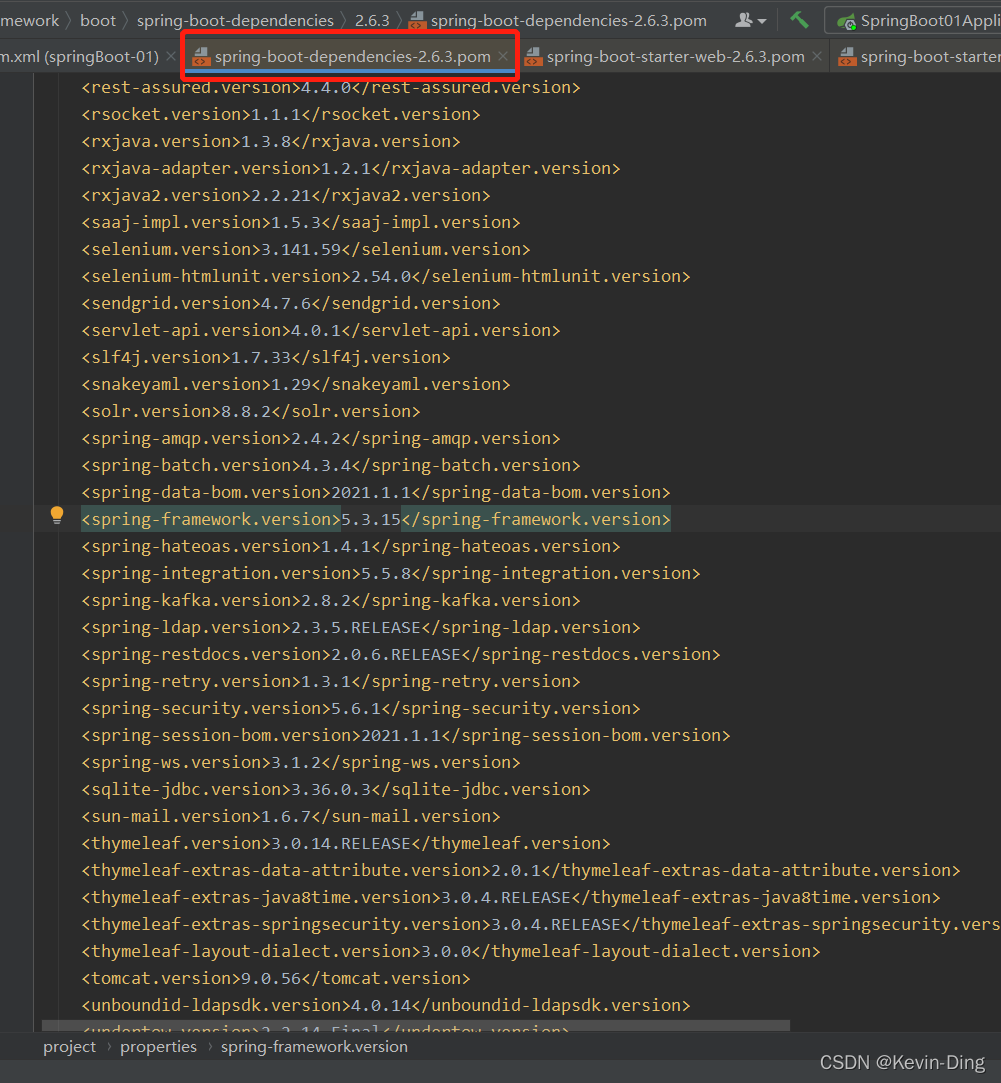SpringBoot基本原理初探
上文书说道,SpringBoot的结构主要包括4个部分:
- pom.xml
- application.properties 配置文件
- 程序的主启动类
- 测试类
本节就接着稍微了解一下基本的原理
1. pom.xml
众所周知,maven项目的pom文件,存放的都是些maven依赖,
springboot项目中的依赖文件:
<?xml version="1.0" encoding="UTF-8"?>
<project xmlns="http://maven.apache.org/POM/4.0.0" xmlns:xsi="http://www.w3.org/2001/XMLSchema-instance"
xsi:schemaLocation="http://maven.apache.org/POM/4.0.0 https://maven.apache.org/xsd/maven-4.0.0.xsd">
<modelVersion>4.0.0</modelVersion>
<!--父级依赖-->
<parent>
<groupId>org.springframework.boot</groupId>
<artifactId>spring-boot-starter-parent</artifactId>
<version>2.6.3</version>
<relativePath/> <!-- lookup parent from repository -->
</parent>
<groupId>com.kevin</groupId>
<artifactId>springBoot-01</artifactId>
<version>0.0.1-SNAPSHOT</version>
<name>springBoot-01</name>
<description>springBoot-01</description>
<properties>
<java.version>1.8</java.version>
</properties>
<dependencies>
<!--web场景的starter启动器-->
<dependency>
<groupId>org.springframework.boot</groupId>
<artifactId>spring-boot-starter-web</artifactId>
</dependency>
<!--springboot的单元测试启动-->
<dependency>
<groupId>org.springframework.boot</groupId>
<artifactId>spring-boot-starter-test</artifactId>
<scope>test</scope>
</dependency>
</dependencies>
<build>
<plugins>
<!--项目打包插件-->
<plugin>
<groupId>org.springframework.boot</groupId>
<artifactId>spring-boot-maven-plugin</artifactId>
</plugin>
</plugins>
</build>
</project>
- 父级依赖:
<!--父级依赖-->
<parent>
<groupId>org.springframework.boot</groupId>
<artifactId>spring-boot-starter-parent</artifactId>
<version>2.6.3</version>
<relativePath/> <!-- lookup parent from repository -->
</parent>
点开artifactId标签中的:spring-boot-starter-parent进去,发现里面还有一个父级依赖:
<parent>
<groupId>org.springframework.boot</groupId>
<artifactId>spring-boot-dependencies</artifactId>
<version>2.6.3</version>
</parent>
点击spring-boot-dependencies进去,可以发现,该文件中包含了几乎所有要用到的依赖内容,这才是顶级依赖,springboot版本的控制中心:

一般情况下,我们在创建springboot项目之后,导入依赖不需要写版本号,但是如果在这个顶级依赖中没有所需要的依赖,就需要自行手动配置了。
2. 启动器:spring-boot-starter
在pom文件中可以看到有:spring-boot-starter-web、spring-boot-starter-test;
springboot-boot-starter-xxx:就是spring-boot的场景启动器,譬如:
spring-boot-starter-web,帮我们导入了web模块正常运行所依赖的组件;

SpringBoot将所有的功能场景都抽取出来(类似于公共方法的向上抽取成抽象方法似的),按类别(web、test)做成一个个的starter ,只需要在项目中引入这些starter,那么该启动器中相关的依赖都会被导入 , 我们要用什么功能就导入什么样的场景启动器。
3. 主启动类
创建的项目,默认的主启动类:SpringBoot01Application
package com.kevin;
import org.springframework.boot.SpringApplication;
import org.springframework.boot.autoconfigure.SpringBootApplication;
/**
* @SpringBootApplication 这个注解标注SpringBoot01Application这个类是一个主程序类
* 说明这是一个Spring Boot应用
*/
@SpringBootApplication
public class SpringBoot01Application {
public static void main(String[] args) {
// 这不是一般的run方法,该方法直接启动整个服务
SpringApplication.run(SpringBoot01Application.class, args);
}
}
注解@SpringBootApplication标注了该类是一个主程序类,该注解是springboot的核心,至关重要,点进去(ctrl+鼠标左键)看看该注解都做了些啥:
@Target({ElementType.TYPE})
@Retention(RetentionPolicy.RUNTIME)
@Documented
@Inherited
@SpringBootConfiguration
@EnableAutoConfiguration
@ComponentScan(
excludeFilters = {@Filter(
type = FilterType.CUSTOM,
classes = {TypeExcludeFilter.class}
), @Filter(
type = FilterType.CUSTOM,
classes = {AutoConfigurationExcludeFilter.class}
)}
)
public @interface SpringBootApplication {
}
可以看到该注解中还有很多注解:
@Target、@Retention、@Documented、@Inherited为四个为元注解(元注解可理解为元老级自带注解,可以用于自定义注解,之后再学习)
@componentScan注解
这个注解在Spring中很重要,也十分常见,对应XML配置中的元素,从字面意思可以理解为自动扫描:自动扫描并加载符合条件的组件或者bean , 将这个bean定义加载到IOC容器中
着重来看另外两个注解:
3.1 @SpringBootConfiguration
字面理解:SpringBoot的配置类 。该注解标注在某个类上 , 表示这是一个SpringBoot的配置类;点进去进去这个注解查看
@Target({ElementType.TYPE})
@Retention(RetentionPolicy.RUNTIME)
@Documented
@Configuration
@Indexed
public @interface SpringBootConfiguration {
@AliasFor(
annotation = Configuration.class
)
boolean proxyBeanMethods() default true;
}
该注解中又有几个注解,可以着重看一下**@Configuration**这一注解,该注解表示这类是一个配置类,对应spring的配置文件;再深入到这个注解中看:
- @Configuration
@Target({ElementType.TYPE})
@Retention(RetentionPolicy.RUNTIME)
@Documented
@Component
public @interface Configuration {
// ......
}
这个注解中@Component,表明该类就是一个spring组件
因此通过对@SpringBootConfiguration这个启动类的深入了解,可以发现该启动类本身也是Spring中的一个组件而已,负责启动应用!
3.2 @EnableAutoConfiguration
该注解:开启自动配置功能,在使用springboot之前,我们需要自己进行配置的各种配置文件,而现在SpringBoot可以自动帮我们配置 ;@EnableAutoConfiguration告诉SpringBoot开启自动配置功能,这样自动配置才能生效;
继续进入该注解内部:
@Target({ElementType.TYPE})
@Retention(RetentionPolicy.RUNTIME)
@Documented
@Inherited
@AutoConfigurationPackage
@Import({AutoConfigurationImportSelector.class})
public @interface EnableAutoConfiguration {
// ......
}
同样的,@Target、@Retention、@Documented、@Inherited为四个为元注解为4个元注解,着重看一下**@AutoConfigurationPackage和@Import({AutoConfigurationImportSelector.class})**
这两个注解。
- @AutoConfigurationPackage:自动配置包,进入该注解:
@Target({ElementType.TYPE})
@Retention(RetentionPolicy.RUNTIME)
@Documented
@Inherited
@Import({Registrar.class})
public @interface AutoConfigurationPackage {
// ......
}
? @Import({Registrar.class}):Spring底层注解@import , 给容器中导入一个组件,Registrar.class 作用:将主启动类的所在包及包下面所有子包里面的所有组件扫描到Spring容器 ;
- @Import({AutoConfigurationImportSelector.class}) :给容器导入组件
导入的组件为:AutoConfigurationImportSelector :自动配置导入选择器,
该组件会导入哪些组件的选择器呢?点击去这个类看源码:
该类中有一个getCandidateConfigurations方法:获取候选配置:
protected List<String> getCandidateConfigurations(AnnotationMetadata metadata, AnnotationAttributes attributes) {
List<String> configurations = SpringFactoriesLoader.loadFactoryNames(this.getSpringFactoriesLoaderFactoryClass(), this.getBeanClassLoader());
Assert.notEmpty(configurations, "No auto configuration classes found in META-INF/spring.factories. If you are using a custom packaging, make sure that file is correct.");
return configurations;
}
//上面方法中的getSpringFactoriesLoaderFactoryClass()方法 返回的就是我们最开始看的启动自动导入配置文件的注解类;EnableAutoConfiguration
protected Class<?> getSpringFactoriesLoaderFactoryClass() {
return EnableAutoConfiguration.class;
}
- 获取候选配置的方法又调用了 SpringFactoriesLoader 类的静态方法loadFactoryNames(),点进去loadFactoryNames() 方法看看:
public static List<String> loadFactoryNames(Class<?> factoryType, @Nullable ClassLoader classLoader) {
ClassLoader classLoaderToUse = classLoader;
if (classLoader == null) {
classLoaderToUse = SpringFactoriesLoader.class.getClassLoader();
}
String factoryTypeName = factoryType.getName();
return (List)loadSpringFactories(classLoaderToUse).getOrDefault(factoryTypeName, Collections.emptyList());
}
它又调用了 loadSpringFactories 方法,再进去看看:
private static Map<String, List<String>> loadSpringFactories(ClassLoader classLoader) {
Map<String, List<String>> result = (Map)cache.get(classLoader);
if (result != null) {
return result;
} else {
HashMap result = new HashMap();
try {
// 从"META-INF/spring.factories"中获取资源并开始遍历获取到的资源
Enumeration urls = classLoader.getResources("META-INF/spring.factories");
while(urls.hasMoreElements()) {
URL url = (URL)urls.nextElement();
UrlResource resource = new UrlResource(url);
Properties properties = PropertiesLoaderUtils.loadProperties(resource);
Iterator var6 = properties.entrySet().iterator();
while(var6.hasNext()) {
Entry<?, ?> entry = (Entry)var6.next();
String factoryTypeName = ((String)entry.getKey()).trim();
String[] factoryImplementationNames = StringUtils.commaDelimitedListToStringArray((String)entry.getValue());
String[] var10 = factoryImplementationNames;
int var11 = factoryImplementationNames.length;
for(int var12 = 0; var12 < var11; ++var12) {
String factoryImplementationName = var10[var12];
((List)result.computeIfAbsent(factoryTypeName, (key) -> {
return new ArrayList();
})).add(factoryImplementationName.trim());
}
}
}
result.replaceAll((factoryType, implementations) -> {
return (List)implementations.stream().distinct().collect(Collectors.collectingAndThen(Collectors.toList(), Collections::unmodifiableList));
});
cache.put(classLoader, result);
return result;
} catch (IOException var14) {
throw new IllegalArgumentException("Unable to load factories from location [META-INF/spring.factories]", var14);
}
}
}
classLoader.getResources("META-INF/spring.factories");
通过类加载器classLoade从"META-INF/spring.factories"中获取资源(getResources),并对获取到的内容开始进行遍历,那么我们就去找找这个spring.factories:
- spring.factories

在这个里面,找一个比较熟悉的WebMvcAutoConfiguration自动配置类,打开瞧瞧:

可以看到这些一个个的都是JavaConfig配置类,而且都注入了一些Bean。
所以,自动配置真正实现是从classpath中搜寻所有的META-INF/spring.factories配置文件 ,并将其中对应的 org.springframework.boot.autoconfigure. 包下的配置项,通过反射实例化为对应标注了 @Configuration的JavaConfig形式的IOC容器配置类 , 然后将这些都汇总成为一个实例并加载到IOC容器中。
如何识别需要加载的配置文件呢?哪些需要哪些不需要呢?

3.3 结论
- SpringBoot在启动的时候从类路径下的META-INF/spring.factories中获取EnableAutoConfiguration指定的值
- 将这些值作为自动配置类导入容器 , 自动配置类就生效 , 帮我们进行自动配置工作;
- 整个J2EE的整体解决方案和自动配置都在springboot-autoconfigure的jar包中;
- 它会给容器中导入非常多的自动配置类 (xxxAutoConfiguration), 就是给容器中导入这个场景需要的所有组件 , 并配置好这些组件 ;
- 有了自动配置类 , 免去了我们手动编写配置注入功能组件等的工作;
4. 主启动类的运行
SpringApplication.run分析:
进到SpringApplication类的run方法中:
public static ConfigurableApplicationContext run(Class<?> primarySource, String... args) {
return run(new Class[]{primarySource}, args);
}
//进入到return的run方法中:
public static ConfigurableApplicationContext run(Class<?>[] primarySources, String[] args) {
return (new SpringApplication(primarySources)).run(args);
}
先根据获取到的资源(primarySources)实例化SpringApplication,再调用run方法:
- 实例化:
这个类主要做了以下四件事情:
1、推断应用的类型是普通的项目还是Web项目
2、查找并加载所有可用初始化器 , 设置到initializers属性中
3、找出所有的应用程序监听器,设置到listeners属性中
4、推断并设置main方法的定义类,找到运行的主类
SpringApplication的构造方法:
public SpringApplication(ResourceLoader resourceLoader, Class<?>... primarySources) {
// ......
this.applicationContextFactory = ApplicationContextFactory.DEFAULT;
this.applicationStartup = ApplicationStartup.DEFAULT;
this.resourceLoader = resourceLoader;
Assert.notNull(primarySources, "PrimarySources must not be null");
this.primarySources = new LinkedHashSet(Arrays.asList(primarySources));
this.webApplicationType = WebApplicationType.deduceFromClasspath();
this.bootstrapRegistryInitializers = new ArrayList(this.getSpringFactoriesInstances(BootstrapRegistryInitializer.class));
this.setInitializers(this.getSpringFactoriesInstances(ApplicationContextInitializer.class));
this.setListeners(this.getSpringFactoriesInstances(ApplicationListener.class));
this.mainApplicationClass = this.deduceMainApplicationClass();
}
- 进入run方法查看:
public ConfigurableApplicationContext run(String... args) {
long startTime = System.nanoTime();
DefaultBootstrapContext bootstrapContext = this.createBootstrapContext();
ConfigurableApplicationContext context = null;
this.configureHeadlessProperty();
SpringApplicationRunListeners listeners = this.getRunListeners(args);
listeners.starting(bootstrapContext, this.mainApplicationClass);
try {
ApplicationArguments applicationArguments = new DefaultApplicationArguments(args);
ConfigurableEnvironment environment = this.prepareEnvironment(listeners, bootstrapContext, applicationArguments);
this.configureIgnoreBeanInfo(environment);
Banner printedBanner = this.printBanner(environment);
context = this.createApplicationContext();
context.setApplicationStartup(this.applicationStartup);
this.prepareContext(bootstrapContext, context, environment, listeners, applicationArguments, printedBanner);
this.refreshContext(context);
this.afterRefresh(context, applicationArguments);
Duration timeTakenToStartup = Duration.ofNanos(System.nanoTime() - startTime);
if (this.logStartupInfo) {
(new StartupInfoLogger(this.mainApplicationClass)).logStarted(this.getApplicationLog(), timeTakenToStartup);
}
listeners.started(context, timeTakenToStartup);
this.callRunners(context, applicationArguments);
} catch (Throwable var12) {
this.handleRunFailure(context, var12, listeners);
throw new IllegalStateException(var12);
}
try {
Duration timeTakenToReady = Duration.ofNanos(System.nanoTime() - startTime);
listeners.ready(context, timeTakenToReady);
return context;
} catch (Throwable var11) {
this.handleRunFailure(context, var11, (SpringApplicationRunListeners)null);
throw new IllegalStateException(var11);
}
}
ruan方法的执行流程(this picture references from狂神说):
